Miasma - Study guides, Class notes & Summaries
Looking for the best study guides, study notes and summaries about Miasma? On this page you'll find 151 study documents about Miasma.
Page 4 out of 151 results
Sort by
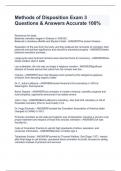
-
Methods of Disposition Exam 3 Questions & Answers Accurate 100%
- Exam (elaborations) • 12 pages • 2024
- Available in package deal
-
- $11.49
- + learn more
Methods of Disposition Exam 3 Questions & Answers Accurate Reverence for dead, Believed cremation began in Greece in 1000 BC, Believed in shadowy afterlife and Elysian Fields - ANSWERThe ancient Greeks... Separation of the soul from the body, and they believed the remnants of cremation held personal and spiritual significance and should be entombed properly - ANSWERGreeks believed cremation provided... Large pyres were built and remains were returned home for ceremony - ANSWERWhen Greek...
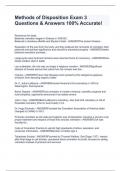
-
Methods of Disposition Exam 3 Questions & Answers 100% Accurate!
- Exam (elaborations) • 12 pages • 2024
- Available in package deal
-
- $13.99
- + learn more
Reverence for dead, Believed cremation began in Greece in 1000 BC, Believed in shadowy afterlife and Elysian Fields - ANSWERThe ancient Greeks... Separation of the soul from the body, and they believed the remnants of cremation held personal and spiritual significance and should be entombed properly - ANSWERGreeks believed cremation provided... Large pyres were built and remains were returned home for ceremony - ANSWERWhen Greek soldiers died in battle Lay undertaker, the role was no ...
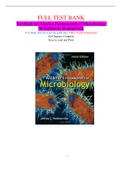
-
Test Bank for Alcamos Fundamentals of Microbiology 9th Edition by Pommerville (All Chapters Complete, All Answers Verified 100%)
- Exam (elaborations) • 713 pages • 2023
- Available in package deal
-
- $32.49
- 1x sold
- + learn more
Test Bank for Alcamos Fundamentals of Microbiology 9th Edition by Pommerville Test Bank for Alcamos Fundamentals of Microbiology 9th Edition by Pommerville Chap01, Chapter 1 Multiple Choice 1. Who was one of the early natural philosophers who coined the name “cella” for the empty cork spaces that became the word we use today, “cells”? A. Robert Hooke B. Zacharias Janssen C. Francesco Stalluti D. Giovanni Faber Ans: A 2. Leeuwenhoek made lenses that allowed him to magnify o...
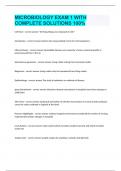
-
MICROBIOLOGY EXAM 1 WITH COMPLETE SOLUTIONS 100%
- Exam (elaborations) • 16 pages • 2023
- Available in package deal
-
- $12.99
- + learn more
MICROBIOLOGY EXAM 1 WITH COMPLETE SOLUTIONS 100% Cell thory - correct answer "All living things are composed of cells" Animalcules - correct answer Antwon Van Leeuwenhoek's term for microorganisms Miasma theory - correct answer Spreadable diseases are caused by a heavy, unnatural quality or poisonous particles in the air Spontaneous generaion - correct answer Living matter arising from inanimate matter Biogenesis - correct answer Living matter only be reproduced from living mat...
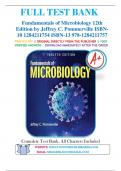
-
Test Bank for Fundamentals of Microbiology 12th Edition by Jeffrey C. Pommerville 9781284211757 Chapter 1-27 | Complete Guide A+
- Exam (elaborations) • 715 pages • 2023
-
- $19.99
- + learn more
Test Bank for Alcamos Fundamentals of Microbiology 9th Edition by Pommerville Chap01, Chapter 1 Multiple Choice 1. Who was one of the early natural philosophers who coined the name “cella” for the empty cork spaces that became the word we use today, “cells”? A. Robert Hooke B. Zacharias Janssen C. Francesco Stalluti D. Giovanni Faber Ans: A 2. Leeuwenhoek made lenses that allowed him to magnify objects more than 200X. However, he failed to promote scientific inquiry because: A. he didn'...
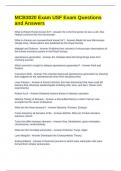
-
MCB3020 Exam USF Exam Questions and Answers
- Exam (elaborations) • 6 pages • 2024
- Available in package deal
-
- $12.49
- + learn more
What is Robert Hooke known for? - Answer-He is the first person to see a cell. Also Helped construct the first microscope. What is Antonie van Leeuwenhoek known for? - Answer-Made His own Microscope (Single-lens), Observations also published by the Royal Society. Malpighi and Odierna - Answer-Published two volumes of microscopic observations of the human excretory system in the Royal Society spontaneous generation - Answer-the mistaken idea that living things arise from nonliving source...
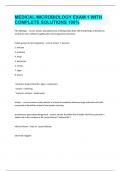
-
MEDICAL MICROBIOLOGY EXAM 1 WITH COMPLETE SOLUTIONS 100%
- Exam (elaborations) • 12 pages • 2023
- Available in package deal
-
- $12.99
- + learn more
MEDICAL MICROBIOLOGY EXAM 1 WITH COMPLETE SOLUTIONS 100% Microbiology: - correct answer specialized area of biology that deals with living things ordinarily too small to be seen without magnification (microorganisms/microbes) Major groups of microorganisms - correct answer 1. bacteria 2. archaea 3. protozoa 4. fungi 5. helminths 6. viruses 7. algae 8. prions *protozoa, fungi, helminths, algae = eukaryotes *viruses = nonliving * bacteria, archaea = prokaryotes viruses: - corr...
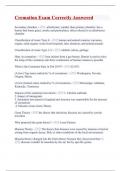
-
Cremation Exam Correctly Answered
- Exam (elaborations) • 24 pages • 2024
- Available in package deal
-
- $11.99
- + learn more
Secondary chamber - -afterburner; smaller than primary chamber; has a burner that burns gases, smoke and particulates; often referred to as afterburner chamber Classification of waste Type 4: - human and animal remains; carcasses, organs, solid organic waste from hospitals, labs, abattoirs, and animal pounds. Classification of waste Type 1-3: - rubbish, refuse, garbage Heat: in cremation- - heat initiate from a gas burner. Burner is used to raise the temp of the cremation unit there...
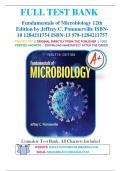
-
Test Bank for Fundamentals of Microbiology 12th Edition by Jeffrey C. Pommerville 9781284211757 Chapter 1-27 | Complete Guide A+
- Exam (elaborations) • 715 pages • 2023
- Available in package deal
-
- $19.99
- + learn more
Test Bank for Alcamos Fundamentals of Microbiology 9th Edition by Pommerville Chap01, Chapter 1 Multiple Choice 1. Who was one of the early natural philosophers who coined the name “cella” for the empty cork spaces that became the word we use today, “cells”? A. Robert Hooke B. Zacharias Janssen C. Francesco Stalluti D. Giovanni Faber Ans: A 2. Leeuwenhoek made lenses that allowed him to magnify objects more than 200X. However, he failed to promote scientific inquiry because: A. he didn'...
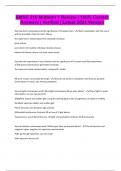
-
BMSC 210 Midterm 1 Review | 100% Correct Answers | Verified | Latest 2024 Version
- Exam (elaborations) • 11 pages • 2024
-
- $9.49
- + learn more
Describe Koch's postulates and the significance of his experiment - Koch's postulates: with the use of anthrax provided a basis for Germ Theory. the experiment: extract blood from diseased individual grow culture put culture into healthy individual, develop disease extract this blood, culture it to show same results Describe the importance of Louis Pasteur and the significance of his swan-neck flask experiment - Disproved spontaneous generation (miasma) the swan-neck made contamination...

That summary you just bought made someone very happy. Also get paid weekly? Sell your study resources on Stuvia! Discover all about earning on Stuvia


